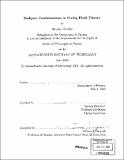Tachyon condensation in string field theory
Author(s)
Moeller, Nicolas, 1975-
DownloadFull printable version (12.25Mb)
Other Contributors
Massachusetts Institute of Technology. Dept. of Physics.
Advisor
Barton Zwiebach.
Terms of use
Metadata
Show full item recordAbstract
In this thesis, we present some results that strongly support Sen's conjectures on tachyon condensation on a bosonic D-brane. Our main tool of analysis is level truncated open bosonic string field theory We use level truncation to check that the energy difference between the local maximum and the local minimum of the open bosonic tachyon effective potential is equal to the tension of a space-filling D-brane (Sen's first conjecture). Our results prove this equality within a precision of about 0.1%. We then construct lump solutions of open bosonic string field theory, which are conjectured by Sen (third conjecture) to be D-branes of lower dimensions. We check that indeed the tensions of lumps of codimension one and two, coincide with the tensions of the respective D-branes within a precision of a few percent. We also give evidence for Sen's second conjecture; that in the nonperturbative tachyon vacuum all open string degrees of freedom must disappear. We show that this is guaranteed if we can write the identity string field I in the form I = QA, where A is some string field and Q is the BRST operator in the true vacuum. We show evidence that the identity can indeed be written in this form. We also analyze the dynamics of tachyon condensation by studying time-dependent solutions of p-adic string theory and level truncated string field theory. Although our rolling solutions conserve energy, their pressure oscillates with diverging amplitudes. These results therefore don't support Sen's proposal of a pressureless tachyon matter.
Description
Thesis (Ph. D.)--Massachusetts Institute of Technology, Dept. of Physics, 2003. Includes bibliographical references (p. 185-197).
Date issued
2003Department
Massachusetts Institute of Technology. Department of PhysicsPublisher
Massachusetts Institute of Technology
Keywords
Physics.